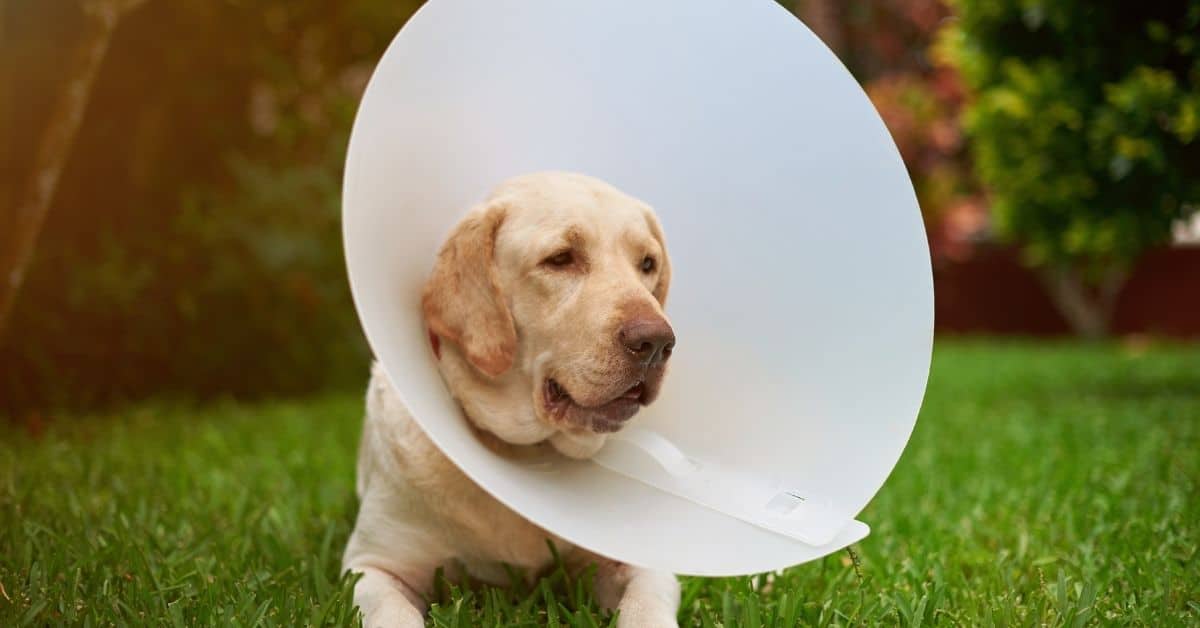After castration or neutering, your dog must wear a cone for 7 to 14 days (up to two weeks).
Two weeks is an estimated recovery time, but it depends on your dog and its healing process.
Your pet’s recovery period depends mainly on your dog’s health, environment, and support during the healing process.
On the other hand, your puppy will fully recover three to four weeks after neutering.
Neutering is a surgical procedure that involves removing the testicles in male dogs.
This surgical procedure is typically performed on puppies aged six to eight weeks to prevent them from engaging in sexual activity.
Your pooch may experience pain and a strong desire to scratch the surgery site.
As you know now the answer to the question “when to take cone off dog after neuter”, continue reading to get more information.
The Benefits Of Wearing A Cone
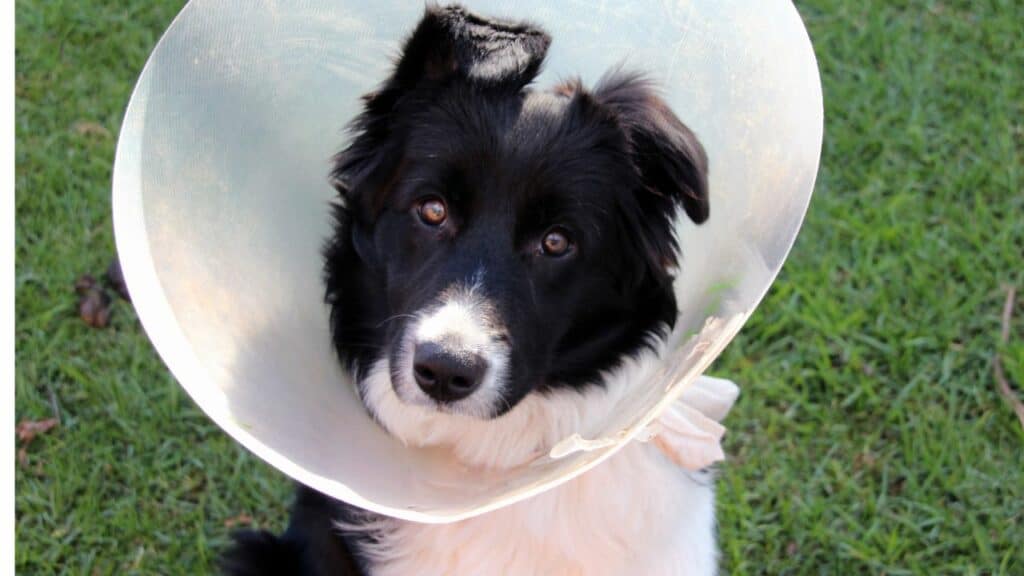
Dog’s cone serves as a barrier and stops your dog from trying to interfere with the wound’s ability to heal completely.
These wounds may include stitches frequently associated with neutering or spaying surgical procedures.
Pets will naturally lick or bite the injured area, so a cone or collar is necessary to create a barrier and keep the exposed area safe.
The use of a cone for your dog after neutering involves several essential aspects:
It promotes healing by keeping the wound or incision site clean
The wounds healing process will be speedy
With this barrier in place, your pet won’t be able to accidentally injure the area or rip out stitches or an incision
The cone will facilitate quick wound healing and prevent secondary injuries that would necessitate expensive medical care and surgery
What To Do If Your Dog Won’t Wear Cone After Neuter?
There are several reasons why your dog may not want to wear a cone after neutering.
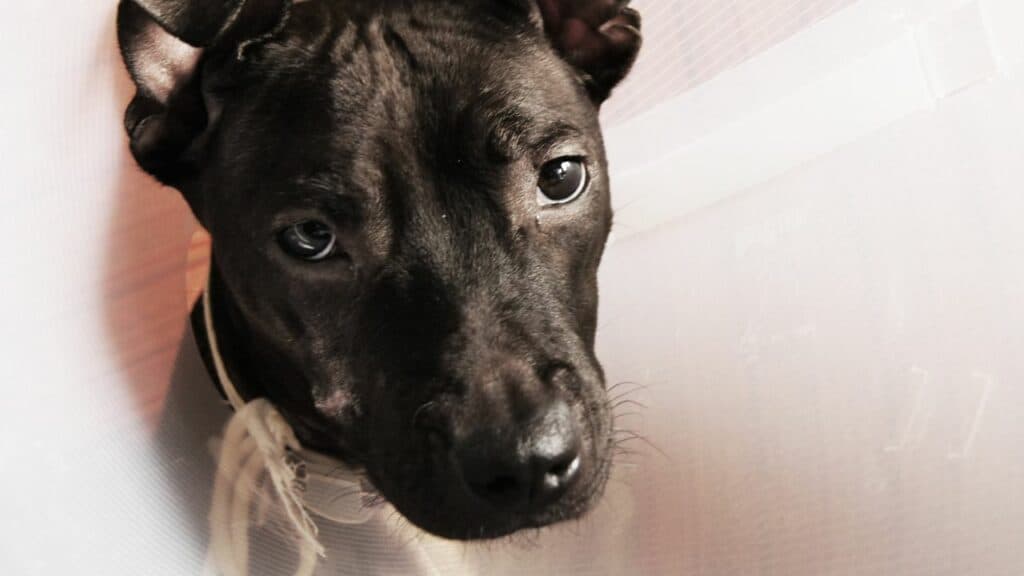
Too Tight Cone
First, make sure the collar is not too tight and securely fastened.
You should be able to fit two fingers between the collar and your dog’s neck if it is too tight.
A cone should also make it simple for your dog to eat, drink, and rest.
Accidental Choking
An unintentional choking may occur if your dog struggles to remove the cone after neutering.
Dogs may become distressed and uncomfortable with it.
If your dog refuses to wear the cone despite your assurance that it is not too tight, you should hold off removing it for a few hours.
In such a situation, contact your vet for alternatives to reduce the risk of further injury.
Try A Different Cone
Cones come in various materials, including plastic, inflatable, soft fabric, and cervical.
If a particular E-collar makes your pooch uncomfortable, try a different cone with vet advice that suits your dog’s needs.
Monitoring Your Dog While Wearing A Cone
You should anticipate that your dog will need to wear a cone for at least one week after having neutering surgery.
Even though this is the bare minimum, your dog’s daily activities, such as feeding, drinking, grooming, and playing, are significantly impacted.
A neutered dog must feel secure while donning a cone because it impairs their ability to navigate their familiar surroundings and can feel upsetting or frightening.
Can My Dog Sleep With A Cone On?
The answer to this is yes.
Dog wears this cone while sleeping and it’s absolutely no problem.
He is also able to eat and drink normally.
Be advised that wearing a cone is not a tool for torture, even though many dog owners think it is.
A dog’s cone or e-collar shields your surgical site from damage and works to prevent your dog from licking or otherwise traumatizing the area, which could lead to infection and the opening of the surgical site.
After a day or two, most dogs get used to the cone, and if the cone is fitted correctly, your dog will feel completely at ease while sleeping in a buster collar.
There is no need to alter your pet’s sleeping arrangements; all that needs to be done is to ensure that, if your dog is crated, he has enough space to turn around without strain and that the cone won’t get tangled or stuck on any bedding or objects.
If your dog sleeps outside of a crate, ensure enough space for him to move around with the cone on and that no furniture or other things are in the way.
How Do You Walk A Dog With A Cone?
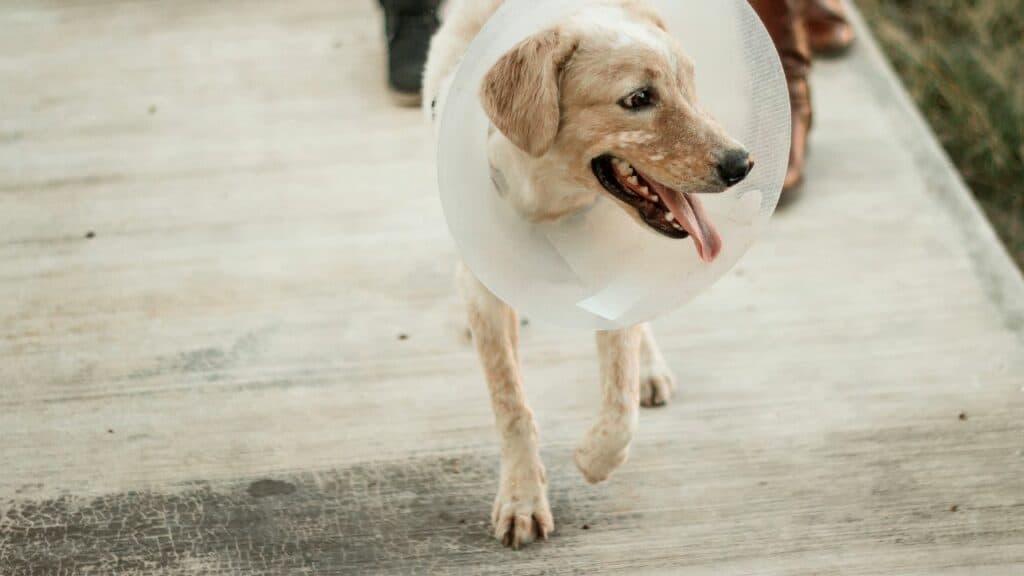
To stop a dog from biting his stitches or licking an injury, veterinarians frequently recommend an e-collar, also known as an Elizabethan collar.
In the home, these collars are not always a welcome addition.
Dogs tend to play while wearing a cone and get stuck; others are terrified of them.
However, a few tips related to dog cones can make walking your dog while wearing an e-collar less stressful than before.
Instead of dragging your dog behind you, walk toward him.
While walking toward your dog will keep the leash taut, pulling him along will make it easy for you to trip over the leash.
Additionally, it will motivate him to short walks before you without dangling his head.
Keep the head of your dog up.
Dogs typically walk with their heads down, so dragging the dog cone can hurt or even hurt your pet.
Use a long leash, tasty treat, or toy to keep the dog’s head high.
What Can I Use Instead Of A Dog Cone?
You can look for alternatives if your dog is unhappy and a traditional e-collar isn’t helping.
Let’s explore different options for our picky canine companions and why dog cones are occasionally necessary.
Soft Collars
As the name implies, these collars are softer and more comfortable fabric for dogs.
Due to their comfort, these are ideal for bedtime.
The fact that the dog cannot see through them makes it more difficult for them to move around, which is another reason why this collar is better used when the dog is sleeping.
Your dog will look even cuter with one of these collars, which also come in adorable patterns and vibrant colors.
Flexible Fabric E-Collars
Some soft e-collars include a hard skeleton as well.
Pets cannot see through them because they are still made of soft fabric, but the hard skeleton makes it more rigid and more like a traditional e-collar, which makes it harder to remove.
Inflatable E-Collars
Another choice is inflatable collars, which might be effective in some circumstances.
If pet owners choose this option, they should carefully monitor the collar’s condition because these collars are prone to punctures.
Additionally, not all body parts may be effectively blocked from access by inflatable e-collars.
Onesies Or Clothing
Onesies or bodysuits are an excellent choice for hotspots or abdominal surgeries that they can cover.
You can buy a bodysuit explicitly made for this, or you might be able to use a fitted t-shirt instead.
How Can I Keep My Dog From Licking A Wound Without A Cone?
An item called the Cone of Shame fastens to your dog’s collar to stop him from licking anything.
This tool is used to shield dogs from harm when they play fetch or when they get their tails bit off.
Your dog won’t be able to lick any injuries he sustains while playing if you use this device.
Good to know at this point: with a cone, it’s also not possible for your dog to lick his paws.
Additionally, you can use this to cover cuts, scrapes, and other open sores.
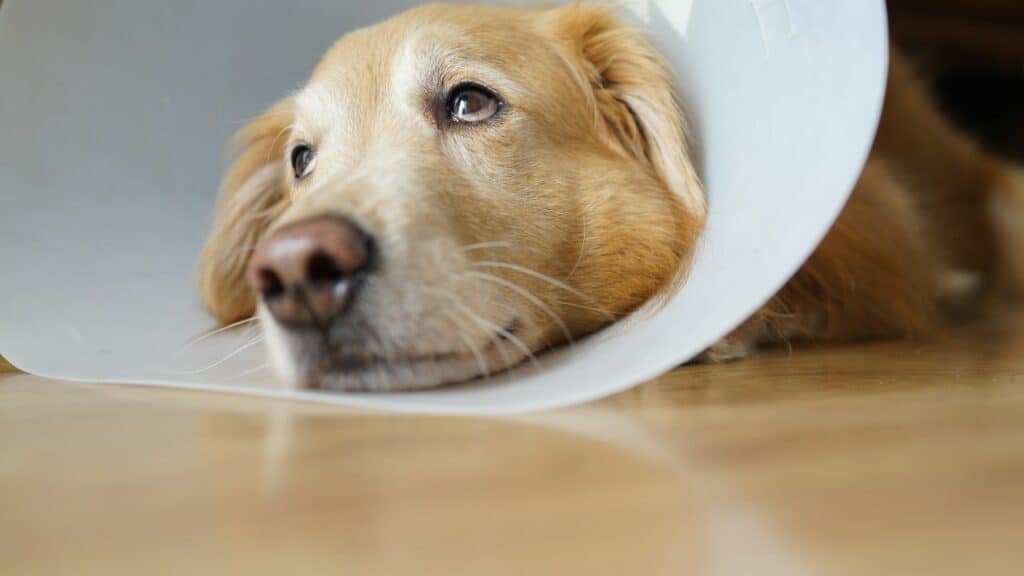
What To Do If The Dog Can Still Lick With A Cone?
They occasionally won’t stop licking if something is bothering a dog.
You can try several things to stop the behavior.
Additionally, think about asking your vet for advice on antiseptic sprays.
Try covering the irritated paw with a bandage made especially for dogs’ feet or even one of your socks wrapped in medical adhesive tape
You can give your dog loose protection that allows air to reach the affected by covering a wound with a T-shirt
You can get a recovery suit to keep your dog safe. When your dog needs to urinate, they can even wear some that fold up or snap out of the way
Veterinarians advise using an adequately fitted Elizabethan collar as the only surefire to prevent a wound from being licked, particularly at night or when you’re not watching the dog
What Is The Recovery Time Of Dissolvable Stitches After Neuter?
The average dissolvable stitch recovery time after dog surgery is 10 to 14 days (two weeks).
Your dog’s incision can withstand the strain and stretch during this time.
Following this time, it will be safe to lick the surgical site.
However, it might take 2 to 6 weeks to completely disappear the stitches.
After surgery dog must wear a protective cone, the internal sutures may take some dogs four months to dissolve.
How Long Does A Male Dog Take To Recover From Neutering?
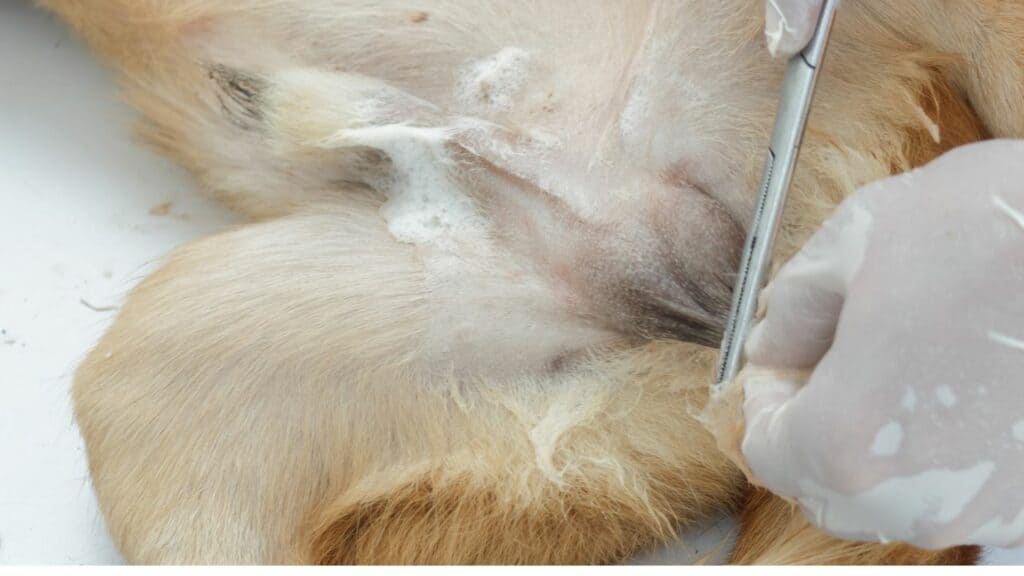
Usually, male dogs between the ages of six and eight weeks are neutered.
In three to four weeks, the majority of neuters will fully recover.
Because they are smaller and have less muscle mass than female neuters, male dog neuters typically take longer to recover.
Additionally, men are more likely than women to experience stress and anxiety.
Most of the time, male neutrally treated dogs perform better than female neutrals.
How Long Does A Female Dog Take To Recover From Neutering?
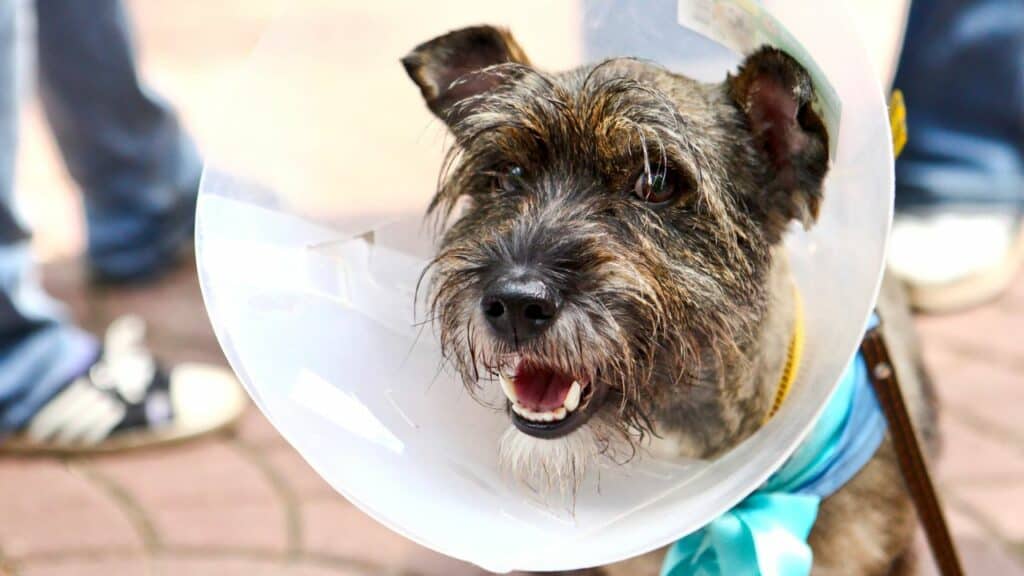
Most dogs begin to feel better in 24–48 hours, but full recovery takes 10–14 days.
You should keep your pet calm during this time and prevent them from jumping, as doing so could lead to the incision reopening.
Every day, the incision should be examined for infection symptoms.
Contact your veterinarian if you notice any swelling, redness, discharge, or unpleasant odors.
Compared to male neuters, female neuters are less painful and spend less time in the recovery room.
Females are typically more resilient and will recover from any injury quickly.
How To Comfort A Dog After Neutering?
The following suggestion will help you comfort your dog after being neuter.
Dog well rested for 24 to 48 hours after neuter surgery
Steer clear of demanding sports or activities
To stop your dog from biting and scratching the incision, have him wear an E-collar or dog’s cone
If there is any bleeding, check the incisions and call your veterinarian immediately
Put your dog in the crate when the dogs cry or act aggressively because of pain
After surgery, be sure to give painkillers at the appropriate time
Before You Go…
Now you know the answer to the question, “When to take cone off dog after neuter?”
If you want to learn more, read the following articles too!

